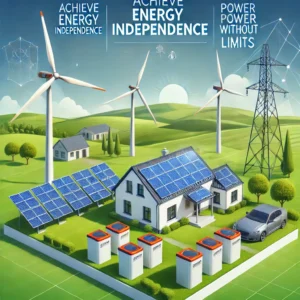 Introduction: The Power of Energy Independence
Introduction: The Power of Energy Independence
Rising energy costs and unpredictable blackouts have led many to seek reliable, self-sufficient power solutions. Energy independence offers the freedom to generate and manage your own electricity, reducing reliance on utility companies and saving money in the process. With off-grid energy solutions and renewable power inventions, you can transform your home into a sustainable energy hub.
This guide explores how self-sufficient energy systems and cutting-edge technologies can help you achieve energy independence, protect against outages, and lower energy costs.
Off-Grid Energy Solutions: Reliable Power Anywhere
Off-grid energy solutions enable you to disconnect from traditional utilities and create your own energy infrastructure. These systems are particularly beneficial for rural areas, remote locations, or those seeking resilience during emergencies.
Components of Off-Grid Systems:
- Energy generation: Solar panels, wind turbines, or hydroelectric systems.
- Energy storage: Batteries or advanced storage units to hold excess power.
- Inverters: Convert energy into usable electricity for your home.
Benefits of Going Off-Grid:
- Cost savings: Eliminate monthly utility bills.
- Energy security: Protect against power outages.
- Environmental impact: Use renewable resources to reduce your carbon footprint.
By implementing an off-grid energy solution, you can enjoy uninterrupted, clean power tailored to your needs.
Renewable Power Inventions: Innovating for Sustainability
The path to energy independence is paved with innovations. Renewable power inventions are at the forefront of sustainable living, combining efficiency with eco-friendly technology.
Key Renewable Inventions:
- Energy independence devices: Compact systems that generate and store power.
- Sustainable energy solutions: Hybrid technologies combining solar, wind, and geothermal energy.
- Energy-saving tools: Devices that monitor and optimize energy consumption.
These technologies not only empower households but also contribute to a more sustainable future.
Self-Sufficient Energy Systems: Power Without Limits
A self-sufficient energy system integrates energy generation, storage, and management into one seamless process. These systems are designed to meet the specific energy needs of your home while remaining adaptable to changing demands.
Steps to Build a Self-Sufficient System:
- Assess your energy needs: Calculate your average daily energy consumption.
- Select your energy sources: Choose a mix of solar, wind, or hydro systems.
- Install energy storage: Use batteries to store surplus energy for later use.
Advantages:
- Uninterrupted power: Always have energy available, even during outages.
- Scalability: Expand the system as your energy needs grow.
- Energy independence: Gain control over your energy usage and costs.
A self-sufficient system is a long-term investment in energy security and sustainability.
Conclusion: Take Charge of Your Energy Future
Energy independence is not just a dream—it’s a practical solution for reducing costs, protecting against outages, and living sustainably. By adopting off-grid energy solutions, exploring renewable power inventions, and building a self-sufficient energy system, you can take control of your energy needs and create a resilient, eco-friendly home.
Imagine a Life Without Power Bills
Right now, you can take control of your energy costs and never fear blackouts again. Edison’s “lost invention” is your chance to generate limitless electricity on demand—for under $200! Don’t wait for the energy giants to tighten their grip on your wallet. Click here to learn how to build your own power independence in just hours.